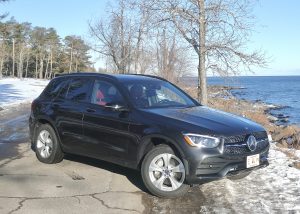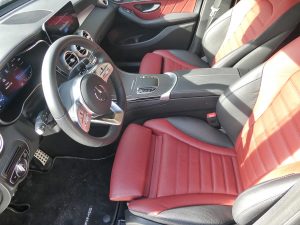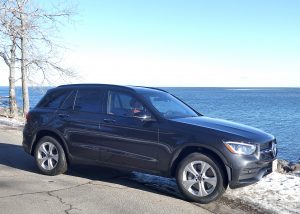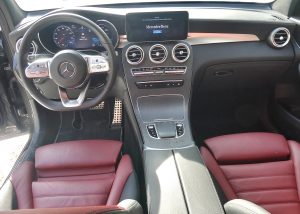Mercedes GLC 300 conquers new world
By John Gilbert
The stereotypical image conjured up is of big, regal sedans or low, sleek sports sedans or roadsters, whenever the name Mercedes-Benz is mentioned. But it’s a new era, and while the Mercedes sedans and sports cars are sleeker and higher-tech than ever, the ideal vehicle for a changing world might be the GLC 300.
A year ago, Motor Trend named the GLC its SUV of the year, because the new vehicle was built up for a bit more interior room as a utility vehicle worth the name, combined with the sportiness demanded by contemporary drivers who want the extra panache of the Mercedes aura.
I got a chance to live with a 2020 Mercedes GLC 300 4Matic SUV for a week a while ago, and suddenly my memory came alive about why I decided I liked the small Mercedes SUV better than any of the fabulous cars from the Stuttgart specialists.
And that takes nothing away from the Mercedes cars, because how can anyone fault any of them? But as U.S. drivers prove their changing preferences with their checkbooks, Mercedes has a full batch of large and midsize SUVs for selection, and nestled in there, the company has placed the GLC.
The formula only makes sense. If buyers want the assets of front-wheel drive for maneuvering and handling in all weather, then why not trim the midsize model down to compact size, making sure there is adequate front and rear head and legroom, and storage space, then lighten it wherever possible and give it snappy, sporty handling and steering. Arm it with a high-performing but small engine, with a transmission that can make it sing, and maybe paddle shifters to allow sporty control of those shifts.
With that, here is the GLC 300, where the number doesn’t relate to the engine displacement the way it used to with Mercedes. In this case, the GLC has a 2.0-liter 4-cylinder with a turbocharger. The turbo is tuned to reach 255 peak horsepower and torque peaking at 271 foot-pounds. That may not sound like much if it were a big, bulky vehicle, but in the lean and mean GLC it’s plenty.
The 9-speed automatic can shift every well by itself, but also has those paddles to allow you to put it in the ratio you want for the situation. And with nine gears, it often might have shifted up too far too soon to give you toe-tapping torque when you need it. Paddle your left fingertip down a couple and you’ve downshifted from ninth to seventh for cruising down an exit ramp, and you can hold it in the lower gear with another couple flicks.
Up in the North Country, on the North Shore of Lake Superior, such controllable shifts are ideal for the packed snow ind slick ice that can cover the highways and hills. But I want to stress another feature of the GLC 300 that surprised me at first, then impressed me — a lot.
We were driving to the Chicago Auto Show, cruising in on Interstates through Milwaukee and then south to Chicago. I had set the destination for the hotel we had registered for, a Suite2 by Hilton, that was brand new and only a couple blocks by skyway from McCormick Place, where the show was. I wanted to skip the tollways that help Illinois folks pay for their highway repairs, even though I appreciate how smooth they are, compared to Minnesota’s frost-heaved pavement.
As we got right to the Chicago area, we had to swing in on the freeway to get to our destination, but ahead, we saw a fog-like greyness that was puzzling. As we got closer, we also saw all kinds of taillights and brake lights. It was snowing, causing the dusky grey, I got over into the right lane of the five lanes we were on, and we were amused that so many people seemed terrified of what we considered a light dusting of snow. And we kept our eye on the nav screen, where a neat diagram of all five lanes showed us exactly where we were and where we should be. I was right there, second lane from the right.
But traffic was thickening and stopping in some lanes as we approached an exit still 5 miles from our destination. Suddenly, my son Jack, my assistant, photographer, and co-pilot, said, “It’s telling us to exit here!”
At a glance, I saw he was right, with the solid blue line that was us, veering up that exit ramp. At a glance in the right side mirror, I realized we had a clear lane to our right, so I promptly swerved, and then swerved again to make it onto the exit ramp, smooth as if it had been planned. I was sure it was in error, but when we got up to the cross-street, we were greeted with flashing lights. A small accident had clogged the intersection a bit, but we were clear. I glanced one more time, and the nav screen did NOT say we should turn left, so having to decide in a millisecond, I continued straight across the street and back down the on-ramp.
As we entered back onto the congested freeway, I felt a little guilty that we had passed about 500 cars and easily merged back into the right traffic lane and continued smoothly to our destination.
Now, I would never suggest that anyone should drive that way, exiting and re-entering just to beat the system, but, hey! The nav lady told us to do it! After we got to our hotel, I started to wonder, and while I have no way to prove it, I believe the guidance system actually sized up the congestion and found a logical way to get around it.
Is that possible?
Well, whether intentional or not, we suddenly felt as though the feature-packed Mercedes GLC 300 had adopted us as its own.
Another surprise is that the sticker price shows $44,500 for the basic GLC 300, and adding virtually every available optional and safety package ran the price up to $60,575, it was still a bargain. The surprise to me was not that the vehicle cost $60-thou, but that you could get it for less than that if you took away some of the items, such as driver assistance, parking assistance, exterior lighting, or multimedia packages, and lower the price to nearly bargain proportions.
Included in those packages are a lot of impressive things, such as high-performance all-season tires, panoramic sunroof, active steering and distance control. active lane change, evasive steering assist, back-up camera with cross-traffic alert and warning.
In short, you can pretty much drive at ease, because your Mercedes is watching out for you. No, you can’t relax, and it doesn’t drive for you, but it allows you to focus on what’s really important on the road ahead, confident that the GLC 300 will alert your, guide you and maybe prevent you from any mistakes that might cause a problem.
And if it suggest you are convinced to exit ahead of plans, and find you’ve cut off about 20 minutes of congested driving, well, you can live with that.







 John Gilbert is a lifetime Minnesotan and career journalist, specializing in cars and sports during and since spending 30 years at the Minneapolis Tribune, now the Star Tribune. More recently, he has continued translating the high-tech world of autos and sharing his passionate insights as a freelance writer/photographer/broadcaster. A member of the prestigious North American Car and Truck of the Year jury since 1993. John can be heard Monday-Friday from 9-11am on 610 KDAL(www.kdal610.com) on the "John Gilbert Show," and writes a column in the Duluth Reader.
John Gilbert is a lifetime Minnesotan and career journalist, specializing in cars and sports during and since spending 30 years at the Minneapolis Tribune, now the Star Tribune. More recently, he has continued translating the high-tech world of autos and sharing his passionate insights as a freelance writer/photographer/broadcaster. A member of the prestigious North American Car and Truck of the Year jury since 1993. John can be heard Monday-Friday from 9-11am on 610 KDAL(www.kdal610.com) on the "John Gilbert Show," and writes a column in the Duluth Reader.